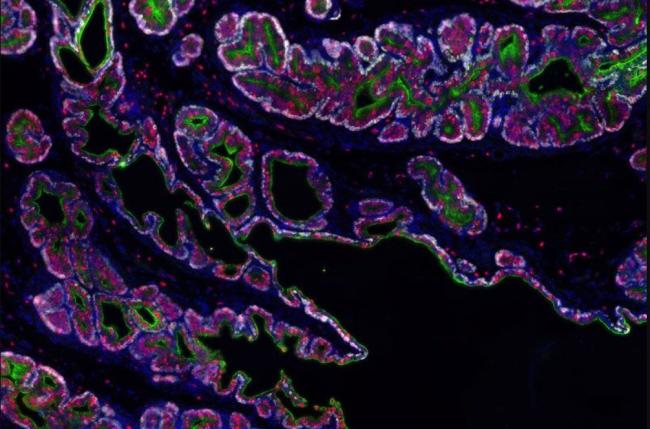New insight into regenerating prostate tissue
May 12, 2020
New insight into regenerating prostate tissue
At a Glance
- Researchers studying how the prostate regenerates after hormone therapy found that an unexpected population of cells plays an important role.
- Understanding the process underlying prostate regeneration could lead to improved therapies for prostate cancer.

In prostate cancer, abnormal cells grow in the tissues of the prostate, a gland in the male reproductive system. About 1 out of 5 men in the U.S. will be diagnosed with prostate cancer. It is most common in older men.
Hormone therapy is standard treatment for men with advanced prostate cancer. Male sex hormones called androgens, which include testosterone, can cause prostate cancer to grow. During treatment, doctors use drugs, surgery, or other hormones to reduce androgens or block them from working.
Androgen deprivation shrinks the prostate gland substantially. This is due to the loss of luminal cells, which form the inside of the hollow prostate. The prostate can regenerate when androgen is restored.
A team of researchers led by Dr. Charles Sawyers of Memorial Sloan Kettering Cancer Center and Aviv Regev at the Broad Institute studied how normal prostate tissue restores itself after androgen deprivation therapy. The work was funded in part by NIH’s National Cancer Institute (NCI). The findings appeared in Science on May 1, 2020.
To explore cell populations in the prostate, the team profiled more than 13,000 cells collected from mouse prostate glands. Using a technique called single-cell RNA sequencing, which can be used to distinguish different cell populations, they identified 22 distinct subsets of cells. Among these were three subsets of luminal cells.
The researchers then studied gene expression of these luminal cells during castration and prostate regeneration. They found that in castrated mice, rare populations of luminal cells became “stemlike,” expressing genes similar to stem cells. Stem cells can develop into many different types of cells, and are known to play a critical role in regenerating some types of tissues.
The researchers also identified a large population of differentiated luminal cells that aid in prostate regeneration. Differentiated cells are mature cells that usually lack stem cells’ ability to self-renew. Further testing in mice and organoids (artificial masses of cells grown to resemble organs) gave insight into how both these types of luminal cells aid in regeneration.
Finally, the researchers analyzed human prostate tissue. They identified similar luminal populations in samples from prostate cancer patients treated with androgen deprivation therapy.
“Androgen-deprivation therapy may be a double-edged sword,” Sawyers says. “Lots of cells die, but the ones that persist acquire this stemlike property.”
The findings suggest that prostate regeneration after hormone therapy may be driven by differentiated and stemlike luminal cells rather than just by a rare population of stem cells. Understanding how luminal cells acquire this enhanced potential to regenerate could have implications for improved prostate cancer therapy.
—by Erin Bryant
Related Links
- Combining Tests More Accurately Diagnoses Prostate Cancer
- Biomarker Signatures of Prostate Cancer
- Genomic Diversity of Metastases Among Men with Prostate Cancer
- Combination Therapy for Metastatic Prostate Cancer
- Prostate Predicaments: When Bladder Problems Are Pressing
- Prostate Cancer


